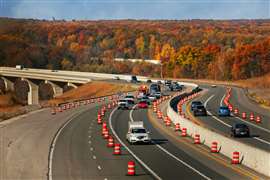‘It’s got to stop’: US contractors demand action to make highway workers safer
29 May 2024
 Image: Kenneth Sponsler via AdobeStock - stock.adobe.com
Image: Kenneth Sponsler via AdobeStock - stock.adobe.com
Michael Alford knows the dangers that speeding and distracted drivers can pose to highways workers only too well.
It’s just over a year since a paving superintendent working for S.T. Wooten Corporation, where Alford is vice president, heavy highway grading and utilities, was fatally struck by a vehicle in Raleigh, North Carolina.
“We know firsthand the dangers of working out in traffic. We have a couple of big interstate projects currently, plus all the resurfacing jobs. We’ve seen things from bottles being thrown at our employees, windows being shot out by BB guns, flaggers being struck.
“And unfortunately in May of last year, we had a paving superintendent who was struck in a lane closure and killed. Several of his employees saw what happened. One of them has not been back to work since because of the trauma. That family had four kids who have lost their dad. That’s something that’s got to stop,” Alford told journalists in a media briefing last week.
It transpired that the driver had been in the country illegally, meaning that they didn’t have a driver’s licence, as well as being impaired. They fled the scene but were caught shortly afterwards.
“We are a safety-first company but with the number of cars that are going by every day, there is only so much we can do,” Alford continued. “We try to tell our guys to work with their head on a swivel because you never know what is coming up behind you or beside you. We’ve had parts fly off of trucks and other vehicles. It’s dangerous out there and the more we can do to protect our employees, the more quickly we can get these roads built and get out of people’s way.”
Alford’s comments came as part of a campaign led by Associated General Contractors of America (AGC) to encourage more enforcement within highway work zones at state and federal level in the US, to encourage better driver behaviour. It is also making a direct appeal to drivers themselves to consider the workers out in the road, producing two videos featuring companies including S.T. Wooten and Balfour Beatty to raise public awareness (see below).
Work zone crashes common, survey finds
A survey conducted by the AGC and HCSS found that nearly two-thirds (64%) of US construction companies undertaking highway upgrade projects reported that motor vehicles had crashed into their construction work zones during the past year (see more on the survey results below or click here for the national results).
The findings add weight to Centers Disease Control and Prevention (CDC) figures that show roadside construction sites alone account for nearly 3% of all fatal workplace incidents annually in the US. Over 2,000 workers lost their lives at road construction sites from 2003 to 2019, or an average of 124 a year, according to CDC data collated by law firm Arnold & Itkin. Meanwhile, about 76% of fatal injuries at roadside job sites from 2011 to 2017 were “transportation events” and around two-thirds of those were workers who were hit by a vehicle in the construction zone, according to Arnold & Itkin.
“While work zones are dangerous year round, those risks only increase during the summer. That’s because it is a time of year when many people take to the road for vacations,” said Jeff Shoaf, CEO of AGC.
“This summer, thanks to the infusion of federal funds from the bipartisan infrastructure bill that was enacted several years ago, that means that even more men and women will be working just a few feet and sometimes inches away from even more speeding vehicles this summer. Unfortunately, drivers are too often distracted. They’re speeding or under the influence when driving through those work zones. Additionally, most states do little or nothing to educate motorists about work zone safety or to protect workers and motorists in those work zones.”
Shoaf said that two-thirds of contractors want states to pass stricter laws against cell phone usage during driving, while 60% want automated enforcement [such as speed cameras] in highway work zones.
He added: “Transportation officials are also too unwilling to provide more separation between workers and motorists.
“64% of contractors report that closing roads and detouring traffic could help improve traffic safety near their work zone. Over the years, we have seen how strong enforcement changes driver behaviour. But too few drivers to the need to slow down and pay attention to work zones because too few states have made work zone safety a top priority.”
Recommended measures
The AGC said it was pushing Congress to require a National Highway Traffic Safety Administration to collect data on work zone crashes, including who is killed or injured. The AGC also wants states to develop behavioural solutions to reduce crashes in highway work zones, while working with its local chapters to push for better enforcement and better education measure measures.
Steve McGough, president and CEO of HCSS, the construction industry software firm that helped to compile the survey said roadway owners should start recognising construction workers as vulnerable road users (VRUs).
“This is important because the Infrastructure Investment and Jobs Act (IIJA) now requires states to create policy and implement programs to better protect VRUs. Unfortunately, most states only think about pedestrians, people with disabilities, cyclists etc. When making plans to protect, they forget workers are part of that community. We need industry to put pressure on the states and other roadway owners to ensure roadway workers are included in their safety plan,” he said.
He also called for increased enforcement in work zones. “Too many work zones have one officer present, which makes it difficult to enforce speeding laws. Let’s make two mandatory or make speed enforcements mandatory,” he said. “Make it at the federal level, enforce it with higher fines or a loss of licence.”
He also recognised the “good news” that the IIJA has allowed the use of federal funds to pay for enforcement. “In just the past year, at least 10 more states have completed or begun the process for state legislation to permit their use. New states include New York, Indiana Kentucky, Washington, California, Michigan, and Illinois updating their laws to cover this,” he said.
“We’re proud of the progress we’ve made so far as and work zone fatalities are coming down, but we still have so much work to do,” he added.
For Alford, while enforcement undoubtedly helps, he believes that ultimately drivers need to start taking more responsibility for their actions.
“We are asking drivers just to be cognisant of what is going on when they drive through those work zones,” he concluded.
“Folks need to slow down – they are running so fast that they don’t have the reaction time. There’s lots of traffic control devices out there and those are great but if folks aren’t paying attention to them then they’re still speeding. The slower you go, the better off everyone is.”
AGC/HCSS Survey results
- 24% of respondents reported experiencing five or more crashes during the past 12 months.
- Among those who reported crashes, 29% experienced crashes that resulted in an injury to a construction worker.
- Among those who reported crashes, two-thirds (66%) of incidents saw drivers or passengers injured.
- 9% of contractors reported that construction workers were killed in work zone crashes.
- Nearly a quarter (24%) of contractors reported drivers or passengers being killed in work zone crashes.
- Nearly half (49%) of contractors report that highway work zones are more dangerous than they were a year ago. Another 48% said they remained as dangerous as in the previous year.
- 65% of contractors think that the current penalties for moving violations in highway work zones are not sufficient to deter unsafe driving behavior.
STAY CONNECTED



Receive the information you need when you need it through our world-leading magazines, newsletters and daily briefings.
CONNECT WITH THE TEAM












